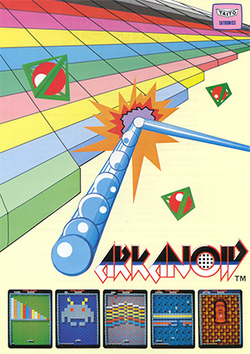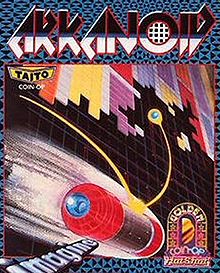- Arkanoid
-
Arkanoid 
European arcade flyer of Arkanoid.Developer(s) Taito Publisher(s) Romstar Designer(s) Akira Fujita Platform(s) Arcade Release date(s) 1986 Genre(s) Breakout Mode(s) Up to 2 players, alternating turns Cabinet Upright Display Vertical, Raster, standard resolution (Used: 224 x 256) Arkanoid (アルカノイド Arukanoido) is an arcade game developed by Taito in 1986. It is based upon Atari's Breakout games of the 1970s. The title refers to a doomed "mothership" from which the player's ship, the Vaus, escapes.
Contents
Overview
 Screenshot of Arkanoid (arcade version)
Screenshot of Arkanoid (arcade version)
Much like the game Breakout, the player controls the "Vaus", a space vessel that acts as the game's "paddle" which prevents a ball from falling from the playing field, attempting to bounce it against a number of bricks. The ball striking a brick causes the brick to disappear. When all the bricks are gone, the player goes to the next level, where another pattern of bricks appears. There are a number of variations (bricks that have to be hit multiple times, flying enemy ships, etc.) and power-up capsules to enhance the Vaus (expand the Vaus, multiply the number of balls, equip a laser cannon, break directly to the next level, etc.), but the gameplay remains the same.
At round 33, the final stage, the player will take on the game's boss, "DOH", a head resembling moai.[1] Once a player reaches round 36, he must defeat DOH with his remaining extra lives because there are no continues on the final round.
The game opens with a monologue stating the following:
"THE TIME AND ERA OF THIS STORY IS UNKNOWN. AFTER THE MOTHERSHIP "ARKANOID" WAS DESTROYED, A SPACECRAFT "VAUS" SCRAMBLED AWAY FROM IT. BUT ONLY TO BE TRAPPED IN SPACE WARPED BY SOMEONE........"
A second monologue is at the end of the game, after destroying the "dimension-controlling fort" that looks like a red wire-frame Moai.
DIMENSION-CONTROLLING FORT "DOH" HAS NOW BEEN DEMOLISHED, AND TIME STARTED FLOWING REVERSELY. "VAUS" MANAGED TO ESCAPE FROM THE DISTORTED SPACE. BUT THE REAL VOYAGE OF "ARKANOID" IN THE GALAXY HAS ONLY STARTED......"
Legacy
Because of the game's popularity, five other versions of the game were developed for the market: Tournament Arkanoid and Revenge of Doh (Arkanoid II) both in 1987, Arkanoid - Doh It Again and Arkanoid Returns both in 1997, Arkanoid DS in 2007,[2] Arkanoid Live, and, most recently, Arkanoid Plus! on WiiWare.
The controls used by various conversions differ from machine to machine, and some conversions allow for multiple control methods. The two basic control methods are digital and analog. Digital controls (many joysticks and control pads, and keyboards) are considered less desirable than analog controls (most mice, trackballs, and paddles); while digital controls limit the player to single-speed control, analog controls allow the player to move the Vaus at nearly any desired speed across the screen. The NES version of Arkanoid was originally packaged with what's considered one of the rarest of all NES controllers, the Vaus Controller: a small gray controller featuring one button, a small spinner (with limited turn radius), an adjustment port, and the Taito logo. While the game may be played with the standard digital NES control pad, optimum gameplay is achieved with the Vaus Controller. Latter-day MAME arcade cabinet developers have created customized spinner controls to further simulate the arcade experience, although the Arkanoid controller had quirks which have made it difficult to achieve 100% reproduction. The Japanese DS version features an optional paddle controller that connects in the Game Boy Advance slot, but the paddle controller is not being released in America.
Reception
The game was reviewed in 1989 in Dragon #144 by Hartley, Patricia, and Kirk Lesser in "The Role of Computers" column. The reviewers gave the game 5 out of 5 stars.[3]
 Front cover of the Atari ST version.
Front cover of the Atari ST version.
Many of the 8-bit computer ports (ZX Spectrum, Amstrad CPC 464, Commodore 64, BBC Micro, MSX, Atari 8-bit, Apple II) were very popular in Europe in the 1980s. A console port on the NES was also popular, and the game was also ported for 16-bit computers Amiga, Atari ST, Apple IIGS and IBM PC. A Macintosh version was released in 1987 and a port was released for the TRS-80 Color Computer in 1989. A Super NES version called Arkanoid: Doh It Again was released in 1997. Arkanoid Returns and a sequel, Arkanoid Returns 2000, were released in Japan for the PlayStation. 16-bit versions had identical graphics as the arcade game. Commodore 64 conversion of Arkanoid is known as the first game for the system to feature music that used digitized samples (composed by Martin Galway). Computer conversions were published by Imagine. A version for the Nintendo DS handheld, titled Arkanoid DS, was released in Japan, with a North American release on August 1, 2008. An unlicensed version for Texas Instruments' popular TI-83 calculator is also available, reflecting, in many ways, the advances in computer technology since its original release.
The Amiga version was reviewed in Computer Gaming World and praised as a perfect version of the arcade game. The review praised the computer versions for playability and features missing from other arcade-style games of the time, such as the ability to continue after all lives are lost.[4]
An Xbox 360 version of Arkanoid, titled Arkanoid Live!, was released on May 6, 2009 on Xbox Live Arcade.[5]
A WiiWare version of Arkanoid, titled Arkanoid Plus!, was released in Japan on May 26, 2009, in PAL regions on August 21, 2009 and in North America on September 28, 2009.[6]
A version of Arkanoid for the iPhone was released worldwide on August 31, 2009 and appeared in the App Store on September 7, 2009.
Clones
Arkanoid has remained a popular game and is commonly cloned by aspiring game developers in freeware and shareware titles. Many companies have also regularly cloned the game in video arcades. Arkanoid's popularity led to it being featured in Rainbow Islands, which has a whole level (4 stages in all) dedicated to the game, including Doh as the level boss. In Alleyway for the original Nintendo Game Boy, Mario is seen on the cover art piloting the Vaus-like paddle. Doom 3: Resurrection of Evil features a clone of the game within one of the usable computer terminals found in the game, which is called "Hellanoid".
See also
- Breakout clones
References
- ^ Anime Super Famicom: Arkanoid: Doh It Again
- ^ IGN: Arkanoid DS, game profile
- ^ Lesser, Hartley, Patricia, and Kirk (April 1989). "The Role of Computers". Dragon (144): 60–68.
- ^ Wagner, Roy (February 1988). "Warped in Space! "Breakout" of a Space Trap with Arkanoid!". Computer Gaming World: pp. 31
- ^ Arkanoid Live! Game Detail Page, xbox.com
- ^ "Art Lessons, Auto Racing, and Arcade Action Multiply the Downloadable Fun". Nintendo of America. 28 September 2009. http://www.nintendo.com/whatsnew/detail/_awl_FLReUbcL1u7VyJEGQAj8UglQUIL. Retrieved 28 September 2009.
External links
- Official Taito/Square-Enix remake site
- Arkanoid at the Killer List of Videogames
- Arkanoid guide at StrategyWiki
- Arkanoid at GameFAQs
- Arkanoid at MobyGames
- Arkanoid at World of Spectrum
- Arkanoid at the Open Directory Project
- Information on the TRS-80 port
Categories:- TI-83&4 series Zilog Z80 games
- Nintendo Wi-Fi Connection games
- 1986 video games
- Amiga games
- Amstrad CPC games
- Apple II games
- Apple IIGS games
- Arcade games
- Atari 8-bit family games
- Atari ST games
- BBC Micro and Acorn Electron games
- Breakout clones
- Commodore 64 games
- DOS games
- Game Boy games
- Mac OS games
- MSX games
- NEC PC-8801 games
- NEC PC-9801 games
- Nintendo Entertainment System games
- PlayStation games
- Satellaview games
- Super Nintendo Entertainment System games
- Taito games
- TRS-80 Color Computer games
- ZX Spectrum games
- Nintendo DS games
- Xbox 360 Live Arcade games
- Xbox 360 games
- IOS games
- WiiWare games
- Wii games
Wikimedia Foundation. 2010.
